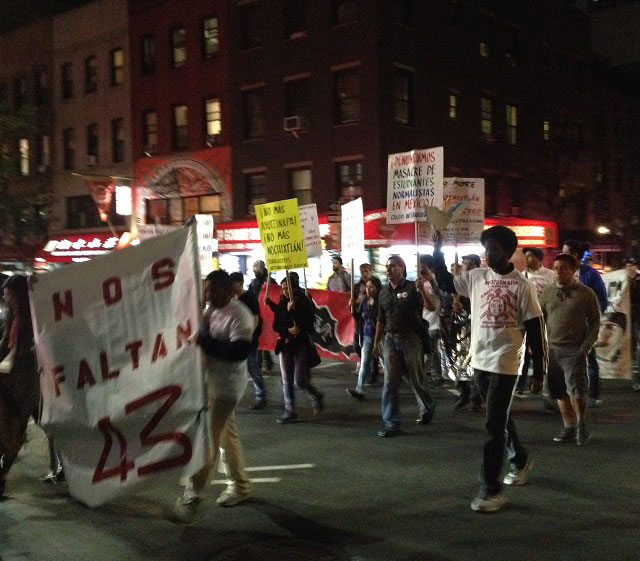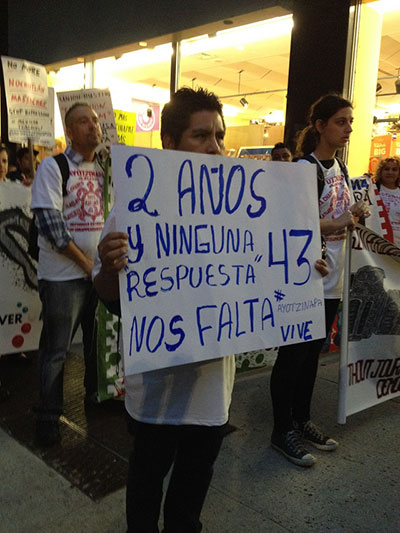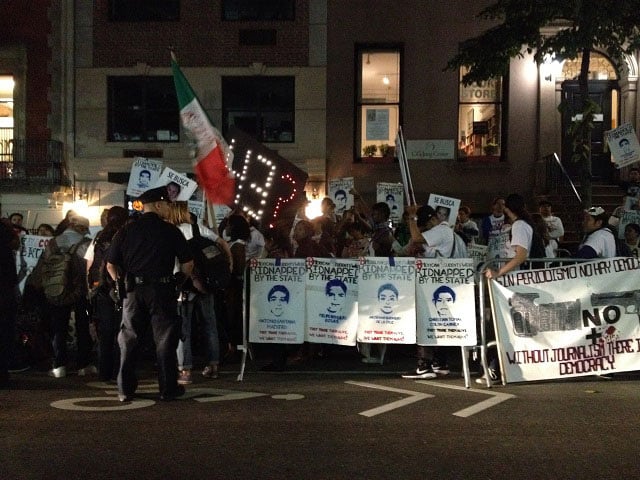
On September 26, 2016, activists and allies gathered in front of the United Nations in New York City to commemorate two years since the disappearance of 43 college students from Ayotzinapa, Mexico.
The group marched from One UN Plaza to the Consulate General of Mexico in New York and then on to Times Square, led by New York residents Antonio Tizapa, father of the disappeared student Jorge Antonio Tizapa Legideño, and Amado Tlatempa, the cousin of another missing student, Jesús Jovany Rodríguez Tlatempa. Refrains of a two-year-old quest for justice briefly interrupted Manhattan’s busy streets. “Alive they were taken,” yelled a spirited young woman into the megaphone, “and alive we want them back!” the marchers responded. “Two years,” read one sign, “and no answers.”
 A participant in the march holds a sign that reads, “Two years and no answers. We are missing 43. Ayotzinapa lives.” (Photo: Samantha Denby)In difficult times, the ritual commemoration of injustice can open the door to hopelessness, which then figures as an uninvited guest that has all along been lurking just beyond our field of vision. The students’ families and their supporters have recorded one month … half a year … a year … and now two years of impunity in the case of the hopeful Mexican teenagers, who were studying to become educators in their rural hometowns. Once the door is ajar, the wind can blow through the curtains with even greater force, carrying visions of future anniversaries for government crimes that will not be prosecuted.
A participant in the march holds a sign that reads, “Two years and no answers. We are missing 43. Ayotzinapa lives.” (Photo: Samantha Denby)In difficult times, the ritual commemoration of injustice can open the door to hopelessness, which then figures as an uninvited guest that has all along been lurking just beyond our field of vision. The students’ families and their supporters have recorded one month … half a year … a year … and now two years of impunity in the case of the hopeful Mexican teenagers, who were studying to become educators in their rural hometowns. Once the door is ajar, the wind can blow through the curtains with even greater force, carrying visions of future anniversaries for government crimes that will not be prosecuted.
Sometimes this breeze can be felt when we gather in the streets and scream: “What do we want? Justice! When do we want it? Now! ¿Que queremos? Justicia! ¿Cuándo? Ahora!“
The phrase boomerangs, between the magic of so many voices booming out in unison, the fear that our words will remain performative in the absence of sufficient action and the dissonance of the demand. Who are we calling out to? Are we asking those in power to administer justice? Are we collectively summoning ourselves to action?
In the case of the students of Ayotzinapa, as in other cases of state terrorism that garner international attention yet remain unresolved, authorities have perfected the strategy of indefinite, bureaucratic postponement. They wield time as a weapon, betting that activists’ energy will be sufficiently drained with the aid of the routine demands of capital: the dwindling of scant resources; physical and psychological illness; the need to feed children; the tenuous quest for joy.
 Speakers read the names of the missing college students in front of the General Consulate of Mexico in New York. (Photo: Samantha Denby)
Speakers read the names of the missing college students in front of the General Consulate of Mexico in New York. (Photo: Samantha Denby)
But perhaps collective commemoration in the streets also partakes in this battle over time. People mark the passage of months and years since an injustice was committed not only to demonstrate their ongoing outrage, but also in order to honor everyday efforts to generate something distinct: some other kind of time.
Many seasons are measured in straight-up resistance. This spring, the Mexican government terminated the independent inquiry into the students’ disappearance, the team of experts published its damning but inconclusive report, and now a tremendous amount of work must be done just so that any credible investigation can continue. People leap forward, fall back hard, and grasp shaky supports in order to regain their footing.
But the families of the students — along with the international community of Mexican and Chican@ activists and allies who mobilize for Ayotzinapa — are some of the most resilient and energetic organizers around, and they remind us that commemorating an anniversary of state violence also means gathering to honor all of the alternatives that are cultivated, day by day, between anniversaries. What is celebrated are the communities, created in even the most hostile of conditions, from which seasons dictated by rebellious calendars are born.
Truthout Is Preparing to Meet Trump’s Agenda With Resistance at Every Turn
Dear Truthout Community,
If you feel rage, despondency, confusion and deep fear today, you are not alone. We’re feeling it too. We are heartsick. Facing down Trump’s fascist agenda, we are desperately worried about the most vulnerable people among us, including our loved ones and everyone in the Truthout community, and our minds are racing a million miles a minute to try to map out all that needs to be done.
We must give ourselves space to grieve and feel our fear, feel our rage, and keep in the forefront of our mind the stark truth that millions of real human lives are on the line. And simultaneously, we’ve got to get to work, take stock of our resources, and prepare to throw ourselves full force into the movement.
Journalism is a linchpin of that movement. Even as we are reeling, we’re summoning up all the energy we can to face down what’s coming, because we know that one of the sharpest weapons against fascism is publishing the truth.
There are many terrifying planks to the Trump agenda, and we plan to devote ourselves to reporting thoroughly on each one and, crucially, covering the movements resisting them. We also recognize that Trump is a dire threat to journalism itself, and that we must take this seriously from the outset.
After the election, the four of us sat down to have some hard but necessary conversations about Truthout under a Trump presidency. How would we defend our publication from an avalanche of far right lawsuits that seek to bankrupt us? How would we keep our reporters safe if they need to cover outbreaks of political violence, or if they are targeted by authorities? How will we urgently produce the practical analysis, tools and movement coverage that you need right now — breaking through our normal routines to meet a terrifying moment in ways that best serve you?
It will be a tough, scary four years to produce social justice-driven journalism. We need to deliver news, strategy, liberatory ideas, tools and movement-sparking solutions with a force that we never have had to before. And at the same time, we desperately need to protect our ability to do so.
We know this is such a painful moment and donations may understandably be the last thing on your mind. But we must ask for your support, which is needed in a new and urgent way.
We promise we will kick into an even higher gear to give you truthful news that cuts against the disinformation and vitriol and hate and violence. We promise to publish analyses that will serve the needs of the movements we all rely on to survive the next four years, and even build for the future. We promise to be responsive, to recognize you as members of our community with a vital stake and voice in this work.
Please dig deep if you can, but a donation of any amount will be a truly meaningful and tangible action in this cataclysmic historical moment.
We’re with you. Let’s do all we can to move forward together.
With love, rage, and solidarity,
Maya, Negin, Saima, and Ziggy